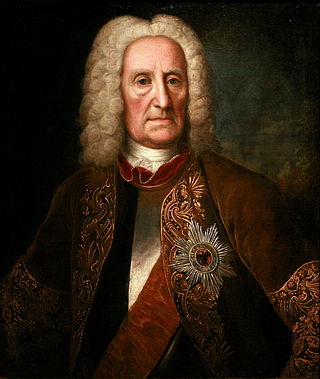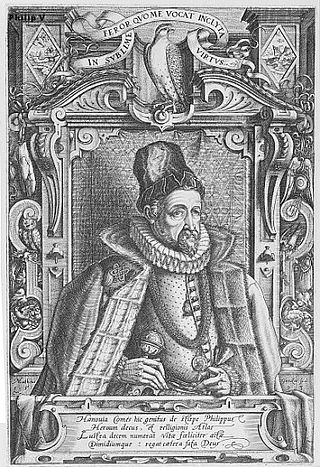Life
He was the son of Kuno of Solms-Lich and Walpurgis of Dhaun-Kyrburg and a younger brother of John of Solms. He studied in Mainz, Heidelberg and Erfurt.
On 15 February 1489 he married Adriana of Hanau (1 May 1470 - 12 April 1524), a daughter of Philipp I, Count of Hanau-Münzenberg and his wife Adriana of Nassau-Siegen. They were related (albeit distantly) and so the marriage required a papal dispensation. The marriage contract stipulated a 5,000 florin dowry with an additional 'widerlage' of 6,000 florins and a 'morgengabe' of 1,000 florins - Philip had some difficulty raising the sum and it was only in 1506 that she received her dowry.
As a councilor at the Imperial court, he strengthened his claims on his lands - in 1494 he was freed from the judgement of the Reichshofgericht or high imperial court. He was also exempted from appearing before all other courts and by so doing the emperor gave up his last rights in the county of Solms-Lich. He probably moved to become a councilor at the court of Frederick III between 1506 and 1514 - there he met the painter Hans Döring, who he made his official painter. He was also drawn by Durer in 1518 and painted by Lucas Cranach the Elder in 1520.
The rebuilding of the Burg Hohensolm around this time was probably undertaken by Philip, whilst he also built a residence at Lich. He, the Landgrave of Hesse and the bishop of Trier were probably the builders of the Marienkirche in Niederweidbach (now a district of Bischoffen) - he paid for the church's altar and he and his family were painted on its donation board, probably by Döring. In 1510 he began rebuilding the Marienstiftskirche in Lich.
On Frederick's behalf Philip concluded a marriage contract between John Frederick and Charles V's sister Katharina in 1519, but the plan failed. In 1520 he and Franz von Sickingen joined forces to protect Martin Luther from possible arrest. Via Ulrich von Hutten, Sickingen asserted Luther's protection and Philip may have offered a safe overnight stay to Luther en route to the 1521 Diet of Worms. After Frederick's death Philip entered the service of Philip I, Landgrave of Hesse. Philip was made ruler of Sonnewalde in Lower Lusatia in 1537 and of Alt-Pouch in 1544. However, he remained Catholic for political reasons when the Landgrave converted to Lutheranism, backing the Holy Roman Emperor on the question of the Augsburg Confession, though he is said to have converted to Lutheranism on his deathbed. He was buried in Lich.
Solms-Laubach was a County of southern Hesse and eastern Rhineland-Palatinate, Germany. The House of Solms had its origins in Solms, Hesse.

Solms-Hohensolms-Lich was at first a County and later Principality with Imperial immediacy in what is today the federal Land of Hessen, Germany. It was ruled by a branch of the House of Solms, originally from Solms.

Johann Reinhard III of Hanau-Lichtenberg was the last of the counts of Hanau-Lichtenberg. He reigned from 1680 to 1736. From 1712 to 1736, he also reigned the County of Hanau-Münzenberg.

Philipp Ludwig I, Count of Hanau-Münzenberg succeeded his father in the government of the County of Hanau-Münzenberg in 1561.

Count Johann Reinhard I of Hanau-Lichtenberg ruled the county of Hanau-Lichtenberg from 1599 to 1625.

Count Phillip III of Hanau-Münzenberg ruled the County of Hanau-Münzenberg from 1529 until his death.

Philipp V of Hanau-Lichtenberg was Count of Hanau-Lichtenberg from 1590 until his death.

Friedrich Casimir of Hanau was a member of the Hanau-Lichtenberg branch of the House of Hanau.
Prince Charles Ferdinand William of Solms-Lich-Hohensolms was a German politician. He was president of the First Chamber of the Estates of the Grand Duchy of Hesse. His sister, Princess Eleonore of Solms-Hohensolms-Lich married Ernest Louis, Grand Duke of Hesse

Count Reinhard IV of Hanau-Münzenberg succeeded in 1500 his father Philipp I of Hanau-Münzenberg (1449–1500) in the government of the County of Hanau-Münzenberg. He served as co-regent from 1496 onwards.
Johann Ernst of Hanau-Münzenberg-Schwarzenfels, was the last Count of the Hanau-Münzenberg line. He succeeded his grand-nephew Philipp Ludwig III in 1641. When Johann Ernst died in 1642, Hanau-Münzenberg fell to the Hanau-Lichtenberg line.
Prince Herman Adolf of Solms-Lich-Hohensolms-Lich was a German nobleman from the House of Solms-Hohensolms-Lich and a politician.

Philipp Moritz of Hanau-Münzenberg succeeded his father as Count of Hanau-Münzenberg in 1612.

Count Philipp I of Hanau-Münzenberg, nicknamed Philipp the Younger, was a son of Count Reinhard III of Hanau and Countess Palatine Margaret of Mosbach. He was the Count of Hanau from 1452 to 1458. The county was then divided between him and his uncle Philipp the Elder. Philipp the Younger received Hanau-Münzenberg and ruled there from 1458 until his death.
Johanna Sibylla of Hanau-Lichtenberg was the first child of Philipp V, Count of Hanau-Lichtenberg from his first marriage with Countess Ludowika Margaretha of Zweibrücken-Bitsch (1540-1569).

Georg II of Fleckenstein Dagstuhl was the last baron of the house of Fleckenstein. He was the eldest son of Philipp Wolfgang of Fleckenstein-Dagstuhl and his first wife, Anna Alexandria of Rappoltstein. Georg II gained considerable power as guardian and regent of the still underage Count Friedrich Casimir and the counties of Hanau-Lichtenberg and Hanau-Münzenberg during the final phases of the Thirty Years' War.

Albert of Hanau-Münzenberg was the younger son of Philip Louis I of Hanau-Münzenberg (1553-1580) and his wife, Countess Magdalene of Waldeck-Wildungen (1558-1599). The only sons of his parents to reach adulthood were Albert and his elder brother Philip Louis II. Albert's son John Ernest was the last male member of the Hanau-Münzenberg line of the House of Hanau.
Countess Anna Sibylle of Hanau-Lichtenberg was a German noblewoman. She was born in Lichtenberg, the eldest surviving daughter of Count Philipp IV and his wife, Countess Eleonore of Fürstenberg.

Countess Adriana of Nassau-Siegen, German: Adriana Gräfin von Nassau-Siegen, official titles: Gräfin zu Nassau, Vianden und Diez, Frau zu Breda, was a countess from the House of Nassau-Siegen, a cadet branch of the Ottonian Line of the House of Nassau, and through marriage Countess of Hanau-Münzenberg.
The County of Hanau-Münzenberg was a territory within the Holy Roman Empire. It emerged when the County of Hanau was divided in 1458, the other part being the county of Hanau-Lichtenberg. Due to common heirs, both counties were merged from 1642 to 1685 and from 1712 to 1736. In 1736 the last member of the House of Hanau died and the Landgrave of Hessen-Kassel inherited the county.
This page is based on this
Wikipedia article Text is available under the
CC BY-SA 4.0 license; additional terms may apply.
Images, videos and audio are available under their respective licenses.














